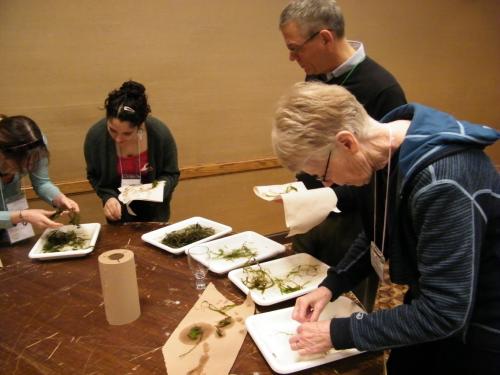Exotic Aquatic Plant Watch helps volunteers detect invasive species in Michigan inland lakes
A joint program between MSU and DEQ provides volunteers with training, guidance and useful tools to successfully identify and map invasive aquatic plants in their lakes.

Recently, during National Invasive Species Awareness Week, Michigan State University Extension and Michigan Sea Grant featured aquatic invasive plants of special interest to Michigan. If you want to help detect invasive plants in your favorite lake, enroll in the Exotic Aquatic Plant Watch by April 1.
Volunteers enrolled in the Exotic Aquatic Plant Watch (EAPW), a component of the MiCorps Cooperative Lakes Monitoring Program (CLMP), are provided with training and knowledge to monitor troublesome exotic, or invasive, aquatic plants in their lakes. Michigan State University Extension staff teach volunteers how to identify four invasive aquatic plants: Eurasian water milfoil (Myriophyllum spicatum), curly-leaf pondweed (Potamogeton crispus), Hydrilla (Hydrilla verticillata) and starry stonewort (Nitellopsis obtusa). By participating in the Exotic Aquatic Plant Watch (EAPW) lake monitors can quickly notice any change in their lakes’ aquatic plant communities.
Invasive plants can drastically change a lake ecosystem by growing into dense mats at the surface outcompeting native plants for space and light, creating poor habitat for juvenile and spawning fish. Heavy plant growth tangles fishing lines, clogs boat props, and impedes access to other recreational activities like swimming and paddling. If detected early, lake communities can employ integrated pest management strategies reducing the probability of an exotic species establishing into a large unmanageable population. While the EAPW plays an important role in the battle against invasive aquatic plants, public participation in the program has, historically, been lower than expected. Therefore, a need arose to conduct some research and take action to improve overall participation in the program.
Starting in 2013, with financial support from the DEQ Water Quality Specialty License Plate Fund, MSU staff conducted some research and identified strategies that were implemented to increase volunteer enrollment and reporting of data. Some of these actions included:
- Staff-assisted lake visits with volunteers. Aid to volunteers in plant identification, clarified sampling and mapping methods, and identified challenges that volunteers faced in the field.
- The creation and distribution of a Michigan State University Extension publication, A Michigan Boater's Guide to Selected Invasive Aquatic Plants (Extension Bulletin E-3189). This light-weight, water-resistant pocket field guide is now provided to all enrolled EAPW volunteers to help with the identification of invasive plants during their survey efforts.
- Improved step-by-step methods for collecting and reporting data while in the field, including location data and digital photographs.

During EAPW trainings, volunteers learn hands-on how to identify invasive aquatic plants and several native look-a-likes. Photo credit: Angela De Palma-Dow
Enrollment and reporting in the program have improved since these strategies were implemented. In 2015, 32 lakes enrolled, and since the program started in 2007, a total of 77 lakes have participated. Researchers were enthusiastic about the increased percentage of enrolled lakes completing their annual surveys and reporting their results from 43 percent in 2011 to 79 percent in 2015. These improvements have resulted in more useful data about the presence or even better, the absence, of invasive aquatic plants in Michigan lakes. However, we think we can do even better!
This spring, Michigan State University Extension staff will be busy promoting the EAPW at several events, such as the Quiet Water Symposium on March 5 and The Great Lakes: Michigan’s Water Heritage Conference on March 8. At the end of April, EAPW annual training will occur during the Michigan Inland Lakes Convention and Michigan State University Extension staff will continue to visit volunteers at their lakes and improve teamwork resources. We are currently working on developing more tools for volunteers who find a new invasive species in their lake, what do you do next?
The success of the EAPW program would not be possible without all of the volunteers that have contributed their time and energy. If you are interested in enrolling your lake in the 2016 Exotic Aquatic Plant Watch, or simply would like to learn more, visit the CLMP pages on the MiCorps website, or contact Jo Latimore at latimor1@msu.edu, 517-432-1491.



 Print
Print Email
Email



